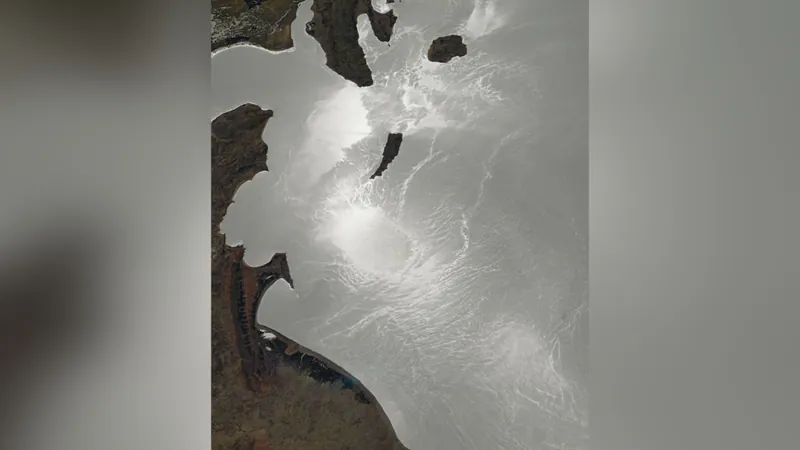
For the First Time Ever, Astronomers Capture Stunning Video of a Distant Star's Turbulent Surface
2024-09-17
Author: John Tan
Groundbreaking Achievement in Astronomy
In a groundbreaking achievement, astronomers have unveiled the first detailed observations of turbulent activity on a star beyond our solar system. A mesmerizing time-lapse video, released on September 11, showcases the violent gas bubbles roiling the surface of a nearby star named R Doradus. This red giant, approximately 300 times larger than our sun, is located about 180 light-years away in the southern constellation of Dorado.
Details of the Observations
Similar to the bubbling of a pot of soup on a stovetop, the scorching material of R Doradus erupts in colossal bubbles that astronomers estimate can expand to 75 times the diameter of our sun. "It is astounding that we can now directly image the intricate details on the surfaces of stars this distant," said Behzad Bojnodi Arbab, a doctoral student at Chalmers University of Technology in Sweden and co-author of a new study published in the prestigious journal Nature. The new observations enable astronomers to study physical phenomena that have only previously been observed on our sun.
Advanced Imaging Technology
The captivating video is constructed from the best images of the star’s tumultuous surface, collected by the Atacama Large Millimeter/submillimeter Array (ALMA), a formidable network of radio telescopes located in Chile. The high-resolution images reveal plasma bubbles, stirred by heat rising from the star’s core, crashing into the surface with such force that they slightly deform the star’s outer layer.
Unexpected Details Unveiled
"This level of detail in our data was totally unexpected," stated study lead author Wouter Vlemmings, a professor at Chalmers University. "We are witnessing convective phenomena on a stellar surface in incredible detail." The observations made from July to August of the previous year suggest that R Doradus’s plasma bubbles exhibit a cycle of rising and falling over about a month—faster than similar movements found on our sun’s surface.
Mysteries of Stellar Dynamics
Why does the convection cycle differ so significantly between R Doradus and our sun? Vlemmings admits they are unsure. Despite the enormous size of R Doradus, its mass is comparable to that of our sun, leading researchers to theorize that it represents a future stage of our sun’s evolution, predicted to occur in approximately five billion years when it transforms into a red giant, engulfing inner planets like Mercury and Venus.
High Spin Rate Considerations
Astonishingly, prior ALMA observations have already revealed that R Doradus spins at least 100 times faster than would typically be expected for a red giant. However, the new study effectively dismisses the idea that this high spin rate might be an optical illusion caused by the turbulent surface activity of the star—an idea recently proposed by other astronomers studying another famous red giant, Betelgeuse.
Research Implications and Future Studies
Vlemmings and his team argue against this hypothesis, emphasizing the distinct rotation period of R Doradus, suggesting a much longer cycle than the one-month convection rhythm of the plasma bubbles. This exciting discovery not only enhances our understanding of stars and their dynamics but also opens new avenues for future research on stellar behavior, paving the way to unlock cosmic mysteries that have eluded scientists for centuries.
Conclusion
As we continue to observe and analyze distant stars, who knows what other unbelievable cosmic phenomena await us in the vast universe? Stay tuned as we delve deeper into the wonders of the cosmos!


 Brasil (PT)
Brasil (PT)
 Canada (EN)
Canada (EN)
 Chile (ES)
Chile (ES)
 Česko (CS)
Česko (CS)
 대한민국 (KO)
대한민국 (KO)
 España (ES)
España (ES)
 France (FR)
France (FR)
 Hong Kong (EN)
Hong Kong (EN)
 Italia (IT)
Italia (IT)
 日本 (JA)
日本 (JA)
 Magyarország (HU)
Magyarország (HU)
 Norge (NO)
Norge (NO)
 Polska (PL)
Polska (PL)
 Schweiz (DE)
Schweiz (DE)
 Singapore (EN)
Singapore (EN)
 Sverige (SV)
Sverige (SV)
 Suomi (FI)
Suomi (FI)
 Türkiye (TR)
Türkiye (TR)
 الإمارات العربية المتحدة (AR)
الإمارات العربية المتحدة (AR)